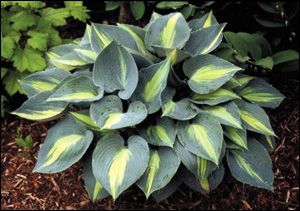 Working at a greenhouse for many years allowed me to see amazing things happen during the life span of hostas (and thousands of other plants). It also gave me the chance to meet some creatures I wish I had never encountered – slugs.
Working at a greenhouse for many years allowed me to see amazing things happen during the life span of hostas (and thousands of other plants). It also gave me the chance to meet some creatures I wish I had never encountered – slugs.
No one invited slugs to the party; they’re gross, inconsiderate, and never leave things how they found them. You may not see them much (slugs are most active at night) but they aren’t exactly careful about covering their tracks.
A slug’s trail is almost unmistakable – slimy when fresh, a shimmery film when dry. What they leave behind isn’t even as bad as what they take away: they leave foliage with more holes than Swiss cheese, decimating every plant they happen to encounter.
Slugs thrive in cool, moist areas, making a beautiful shade garden the ideal habitat. They seem to have a sweet tooth for hostas – perhaps attracted by the beauty and versatility that make hosta so celebrated. Luckily there are hostas that prove to be rather slug resistant, having thicker leaves that are less likely to attract slugs and more difficult for them to damage. Many of the slug-resistant hostas are popular varieties that you may already have in your collection.
“American Sweetheart” has smooth, rounded leaves that are a medium green with a creamy white center. This large, upright hosta brightens up any shady garden and is sure to stand out in a crowd.
“American Sweetheart” attributes:
Height: 20”
Spacing: 54”
Growth Rate: fast
Size: large
Zones: 3-9
“Touch of Class” boasts blue, heart-shaped leaves with a golden center. A spectacular display of lavender flowers makes this a classy addition to any shady space, use it to touch up any dark corner.
“Touch of Class” attributes:
Height: 14”
Spacing: 18”
Growth Rate: slow
Size: small
Zones: 3-9
“Pandora’s Box” is an adorable little treasure. This mini hosta is perfect for pathways, rock gardens, potted planters, and the ever-trending fairy garden. The quarter-sized leaves are cream-filled in the center – so cute!
“Pandora’s Box” attributes:
Height: 8”
Spacing: 10.5”
Growth Rate: moderate
Size: mini
Zones: 3-8
Even with slug-resistant hostas, there is a pretty good chance you’ll still find slugs around a shade garden. While eliminating slugs entirely proves difficult, there are many methods for dealing with a slug problem. If you’re looking to purchase, try Ortho Bug-Geta Snail & Slug Killer (containing metaldehyde, a chemical that can be toxic to animals, so use caution) or Sluggo (a decomposing iron phosphate blend). For a cheaper, more natural approach, consider beer traps, Epsom salt, crushed egg shells, or coffee grounds.
You can remove slugs by hand in the evenings, but unless you want to get slimed, wear gloves. Plant debris and decomposing material appeal to slugs, so clearing out leaves and other dead plant material makes this space less appealing. Consider applying slug killer in the fall as the slugs lay their last batch of eggs – this timing may reduce the slug problem for the following season.
Each hosta variety offers a unique set of character traits, choosing favorites is difficult. HostasDirect offers over 100 of these slug-resistant types. For a complete listing of available varieties visit the HostasDirect website – select “slug resistant”, or narrow the search however you like!
Go get ‘em, slugger!
About the author: Amanda Chouinard has a BA in Communication Studies from St Cloud State University in Minnesota. She is currently employed at HostasDirect (an online retailer of hosta and heuchera) and comes with 9 years of greenhouse experience.